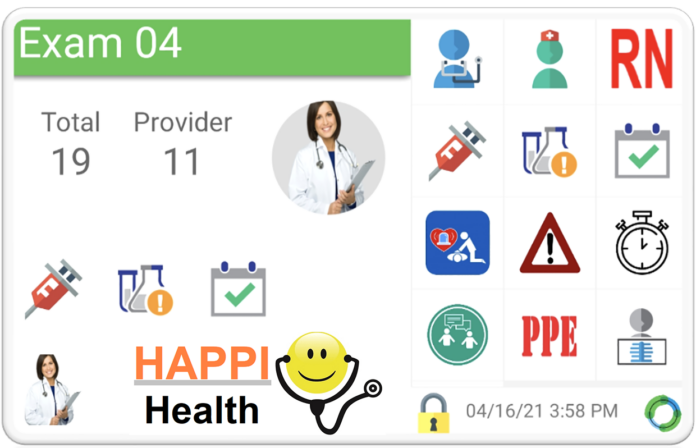HUNTSVILLE — HAPPI Health recently received a double dose of efficiency for patients and staff with its software-driven system SyncTimes. HAPPI Health is a comprehensive family, primary, and urgent care provider.
SyncTimes upgrades the patient experience while improving operational efficiency. HAPPI Health professionals have the ability to locate staff and equipment in real-time, improve communications and data capture, and it allows for easy yet detailed process improvement analysis.
“We decided we wanted to work smarter, which makes everyone happier,” said Ann Kepner, chief operating officer at HAPPI. “Gone are the days when they placed staff in the hallways with clipboards and stop watches. SyncTimes measures room utilization data and much more.”
The SyncTimes system operates through tablets inside and outside of exam rooms, monitored on a flat screen Flowstation display in team room areas.
In addition to indicating when a patient is in the room, the tablets also include real-time sensors that automatically sense beacons worn by the providers and staff as they move through the clinic.
These devices help improve the overall work environment by effortlessly capturing and displaying room utilization data like how long the patient has been in the room, the number of providers and staff time in the room, and how much time the patient has spent alone.
HAPPI Health staff reported three areas where SyncTimes has made significant improvements in operations.
It has decreased total patient visit time by 18% without reducing time with the providers and staff. It has decreased patient time alone by 30%; and it shows an increase in the patient satisfaction rate by more than 40%.
Most significant has been the realization that SyncTimes’ real-time display of patient alone time has caused staff to increase engagement with patients, which leads to happier patients at HAPPI Health.
Even more encouraging, according to Primary Care Physician and Director of Quality Dr. George Kyle, is the system helps in other ways.
“The system takes the data that is collected and displayed during each clinical day and stores it for review later,” Kyle said. “It is so easy to gather and analyze data from yesterday, last week and last month that we now incorporate it into our daily huddle.”
The room tablets also enhance internal communication.
Each device is loaded with patient care plan icons. These allow providers and staff to quickly call for assistance, order lab work or request a translator from a simple touch of an app on the tablet inside the room.
Of the scores of icons, the one most commonly used alerts the providers when and where a patient is ready to be seen. The staff no longer has to search the clinic for a provider.
The provider’s most frequently used icons initiate calls for the medical assistant, the social worker and for point of care testing. Searching for staff has been eliminated.
“The implementation of this new technology has made it much easier for our staff to follow and accomplish our strategic plan,” Kepner said. “These new simple adjustments in our process have quickly improved both the staff and patient experience. That is most gratifying to me”.
Unexpected benefits have also arisen from the process. Staff and providers have noticed patients are arriving on time or early for their appointments at a higher rate. Patients have noticed the decrease in wait times and total visit times and this has motivated them to act as a partner in the process.
According to Kepner, a second unexpected benefit involves recruiting staff and providers.
“Numbers don’t lie,” said Kepner, “and our numbers tell prospective employees that we care about our patients and our work environment. All the health care data in the world is useless unless it improves quality and security from the patient’s perspective, and SyncTimes definitely does that.”
Don’t miss out! Subscribe to our email newsletter to have all our smart stories delivered to your inbox.



